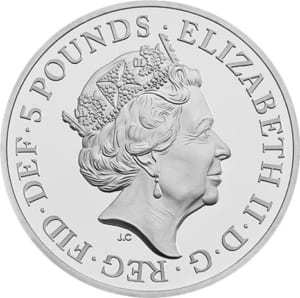The Queen’s portrait has appeared on coinage since 1953, but how will currency change following the Queen’s death?
King Charles III has succeeded the throne, and a new portrait of Charles will be issued on all coins and notes. This will take some time, as the Royal Mint need to get approval for a new portrait which will then be issued on all coinage.
There’s a lot to unpack with this topic, including how old coins will be affected and how long the process will take. Let’s waste no time and get straight into it.
How Will It All Work?
The latest portrait in circulation is the Jody Clark portrait, shown below, issued in 2015.
Whilst technically the 4th portrait of the Queen that can be found in circulation today, there are actually 5 portraits in total that have been used since the Queen came to the throne in 1952.

The first portrait, known as the Mary Gillick portrait, was discontinued after decimalisation to better help the new decimal currency to stand out from the old currency. Similarly to how this portrait was discontinued, the same will happen to the design when the Queen passes, although under much more unfortunate circumstances.
Rather than all of the current coins and notes being handed in, the process will be a gradual one and many of the coins featuring portraits of Queen Elizabeth II will remain in circulation for many years to come. Banks and post offices will issue new design coins and notes, and collect the older versions, easing the country into the new designs.
It will be very similar to what happened following George VI’s death in 1952, although there will be one major difference. At that time there were still a number of coins minted using silver which were hoarded following the succession of the throne by the Queen.
Currently, there are no circulating UK coins minted in precious metals, so there will be much less hoarding of certain coins. It is likely, however, that sought-after commemorative coins will become even more so following the change in obverse design.
The practical fact of the matter is that 99% of the population will not bat an eye at the new designs being used, and it is probably just coin collectors who will be eager to see what new designs await.
Which Other Countries Will Be Affected?
According to Guinness World Records, Queen Elizabeth II features on the coinage of at least 35 different countries, so what happens when she is succeeded?
As head of the Commonwealth, the portrait of the Queen is not just used on currency in the United Kingdom but on many of the countries in the Commonwealth. For example, the Queen appears on the Canadian $20 bill and the Australian dollar coin.
These designs will also have to change alongside the British pound, but the process will be much more gradual in these countries. The main reason for this is that it is much easier to enforce a new design in the country where it originates, rather than in other countries where different jurisdictions may take place.
Some of the other countries that will be affected include Fiji, New Zealand, Cyprus and the Bahamas.
There are many more of course, but this is just to name a few. The design of coinage and notes featuring the Queen in other countries will likely remain for years after she passes, honouring her legacy throughout the world.
How Much Currency Is There to Change To The New Design?
According to the Bank of England, there are over 3.9 billion Bank of England notes currently in circulation with a value of around £71 billion pounds.
The value of banknotes in circulation has increased yearly and most recently by the £20 and £50 pound notes and will continue to do so, but what about coins?
According to the Royal Mint, there are approximately 29 billion coins in circulation in the United Kingdom.
It is clear to see that the process of changing the design will not happen overnight, due to the sheer volume of currency in circulation. It is quite likely, in fact almost a certainty, that Queen Elizabeth II’s designs may remain in circulation for years after the succession of the throne.
How Does This Change The Value Of Coins?
The death of the Queen is significant in many ways, and for the coin-collecting community, it will have a massive impact.
Coins that are currently in circulation will slowly phase out as new coins are issued with a new portrait of King Charles III.
We are already seeing a much higher volume of interest in collectable coins such as the Paddington Bear 50p collection or the William Shakespeare £2 coins, and this is expected to continue for the foreseeable.
As no more coins will be issued for regular circulation with the 5th portrait of the Queen, it is likely that current coins will become more sought after following the change.
What About Coins That Commemorate The Queen?
Coins that specifically commemorate the Queen will likely become even more sought after, as these will hold significant historical commemoration.
Examples of these coins include the 1953 Coronation Crown and the 1977 Jubilee crown, and we will be tracking these coins closely over the coming months to see how the demand and price vary.
